Jan van de Cappelle stands as one of the most distinguished marine painters of the Dutch Golden Age, a period of extraordinary artistic flourishing in the 17th-century Netherlands. Renowned for his exquisitely rendered calm seas, atmospheric skies, and masterful depiction of light, Van de Cappelle captured the serene beauty and maritime pride of his nation. Though a prosperous businessman by trade and largely self-taught as an artist, his passion for painting resulted in a body of work that continues to captivate audiences with its tranquility and technical brilliance.
The Man Behind the Canvas: A Life of Art and Commerce
Jan van de Cappelle was born in Amsterdam, likely between 1625 and 1626, into a wealthy family. His father, Franchoys van de Cappelle, owned a successful dye-works, a business that Jan, along with his brother Louis, would eventually inherit and manage. This financial security afforded him a unique position among his artistic contemporaries: he did not need to paint for a living. Consequently, Van de Cappelle approached art as a passionate avocation rather than a primary profession.
This independence meant he never formally registered with the Amsterdam Guild of Saint Luke, the city's official organization for painters and other craftsmen. Membership in the guild was typically a prerequisite for artists wishing to sell their work or take on apprentices. Van de Cappelle's status as a wealthy amateur allowed him to bypass these conventions, developing his skills largely through self-study and by observing the works of other masters, many of whom he knew personally or whose paintings he owned.
His affluence also enabled him to indulge in his love for the sea directly. He owned a private yacht, which he used to sail along the Dutch coast and inland waterways. These excursions provided him with firsthand experience of the maritime environment – the play of light on water, the varied forms of clouds, and the intricate details of ships – all of which he translated onto his canvases with remarkable fidelity and sensitivity.
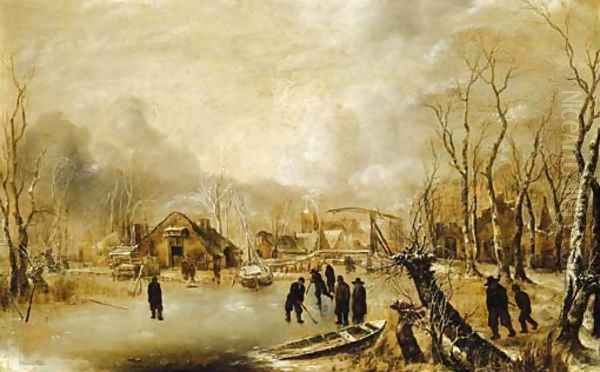
Van de Cappelle married Annetje Jansdr. Grotincx in 1653, and they had several children. His social standing allowed him to move in prominent circles, and he commissioned portraits of himself and his family from leading artists of the day, including Rembrandt van Rijn, Frans Hals, and Gerbrand van den Eeckhout. He passed away in Amsterdam and was buried on December 22, 1679, leaving behind a significant artistic legacy and an even more impressive art collection.
The Soul of the Sea: Artistic Style and Influences
Jan van de Cappelle's artistic output is characterized by an overwhelming sense of calm and luminous beauty. He specialized in marine subjects, particularly tranquil harbor scenes, river estuaries at dawn or dusk, and expansive views of becalmed fleets. Winter landscapes, often featuring frozen canals and skaters, also form a smaller but significant part of his oeuvre, echoing the atmospheric qualities of his seascapes.
A defining feature of his style is his unparalleled ability to render atmospheric perspective and the subtle gradations of light. His skies are vast and airy, often dominating the composition, with meticulously observed cloud formations that diffuse a soft, silvery light across the scene. This light reflects delicately on the still or gently rippling water, creating a harmonious interplay between sky and sea. His palette typically favored cool, subtle tones – silvers, grays, soft blues, and pale ochres – which contribute to the overall serenity of his works.
While largely self-taught, Van de Cappelle was undoubtedly influenced by the work of Simon de Vlieger (c. 1601–1653), a leading marine painter of the preceding generation. De Vlieger was instrumental in moving Dutch marine painting towards a greater naturalism and a focus on atmospheric effects, a direction Van de Cappelle embraced and perfected. Some of Van de Cappelle's early works show a close affinity with de Vlieger's style, but he quickly developed his own distinctive approach, characterized by even greater subtlety in light and a more profound sense of stillness.
Van de Cappelle was a master of composition. His scenes, though often populated with numerous vessels, from imposing States yachts and warships to humble fishing boats and ferries, never feel cluttered. He arranged these elements with a careful eye for balance and spatial recession, leading the viewer's eye gently into the luminous depths of the painting. The ships themselves are rendered with great accuracy, demonstrating his keen observational skills and knowledge of maritime architecture.
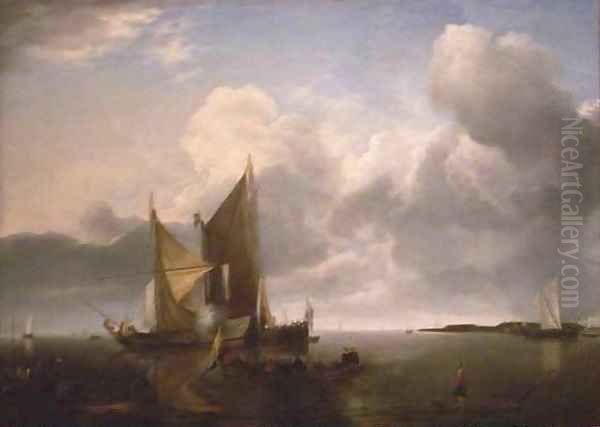
One of his notable innovations, often shared with or inspired by Simon de Vlieger, was the "parade" or "review" scene. These compositions depict ceremonial gatherings of ships, often official vessels at anchor or on a calm sea, creating a sense of stately grandeur and reflecting the maritime power and prosperity of the Dutch Republic. These works are less about narrative action and more about evoking a mood of peaceful order and national pride.
His winter scenes, though fewer in number, display a similar sensitivity to atmosphere and light. Works like Winter Landscape show his ability to capture the crisp air and muted light of a frozen Dutch day, with figures enjoying the ice, reminiscent of the tradition established by earlier masters like Hendrick Avercamp, whose works Van de Cappelle also collected.
Masterpieces of Tranquility: Notable Works
Though his surviving painted oeuvre is relatively small – estimated at fewer than 200 paintings – many are considered masterpieces of the genre.
One of his most iconic paintings is Shipping in a Calm at Flushing with a States General Yacht Firing a Salute (1649, National Gallery, London). This relatively early work already showcases his mature style. A majestic States General yacht, its sails limply hanging, fires a salute, the puff of smoke momentarily disturbing the otherwise profound stillness. Other vessels are scattered across the calm water, their forms softly defined in the hazy light. The vast expanse of sky, with its delicately rendered clouds, creates an atmosphere of immense peace and spaciousness.
A Calm Sea (c. 1650-1655, various versions exist, e.g., Rijksmuseum, Amsterdam) is a title that could apply to many of his works, encapsulating his signature theme. In a typical example, such as A State Yacht and Other Craft in Calm Water (Rijksmuseum), we see a collection of ships at anchor or moving slowly on mirror-like water. The reflections are rendered with exquisite precision, and the overall effect is one of profound serenity. The subtle interplay of light and shadow, the delicate rendering of rigging, and the sense of airy distance are hallmarks of his genius.
Another significant work is Ships in a Calm (c. 1650, Mauritshuis, The Hague). Here, several large ships dominate the foreground, their sails partially furled, indicating the lack of wind. Smaller boats ferry passengers or goods. The scene is bathed in a soft, diffused light that unifies the composition and enhances the tranquil mood. The meticulous detail in the ships contrasts with the broader, more atmospheric treatment of the sky and water.
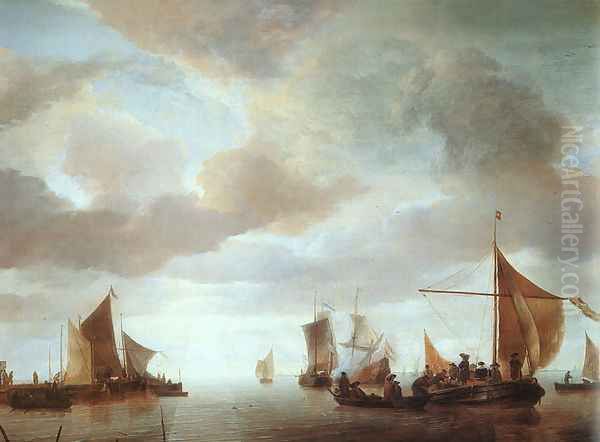
His winter scenes, such as Winter Landscape with Skaters (c. 1650s), also deserve mention. These paintings capture the unique light and atmosphere of a frozen Dutch landscape. Figures are often depicted enjoying themselves on the ice, adding a touch of human warmth to the cool, crisp setting. Van de Cappelle's skill in rendering the texture of ice and the subtle colors of a winter sky is evident in these works.
The consistency of quality across his known works is remarkable, suggesting a meticulous and unhurried approach to his art. Each painting seems to be a carefully considered meditation on light, atmosphere, and the serene beauty of the Dutch waters.
A Circle of Peers: Connections and Contemporaries
Despite not being a guild member, Jan van de Cappelle was well-connected within the Amsterdam art world. His wealth and status as a discerning collector undoubtedly facilitated these relationships. He was not a recluse but an active participant in the cultural life of his city.
His most significant artistic connection was likely with Simon de Vlieger. As mentioned, De Vlieger's influence on Van de Cappelle's style is undeniable, and it is plausible that they knew each other personally. Van de Cappelle owned a substantial number of De Vlieger's paintings and drawings, indicating a deep admiration for his work. Some scholars even suggest an informal mentorship, though concrete proof is lacking.
Van de Cappelle also had dealings with some of the greatest figures of the Dutch Golden Age. He commissioned portraits from Rembrandt van Rijn and Frans Hals, two titans of Dutch painting. The fact that such eminent artists painted his portrait speaks to his social standing and his engagement with the artistic elite. Gerbrand van den Eeckhout, a pupil of Rembrandt, also painted portraits for the Van de Cappelle family.
His collection included works by a veritable who's who of Dutch and Flemish art, suggesting a broad appreciation for different styles and genres. Beyond De Vlieger and Rembrandt, he owned pieces by landscape artists like Jan van Goyen and Jacob van Ruisdael, marine specialists such as Jan Porcellis and Willem van de Velde the Elder and the Younger, and genre painters like Adriaen Brouwer. He even owned works by Flemish masters Peter Paul Rubens and Anthony van Dyck.
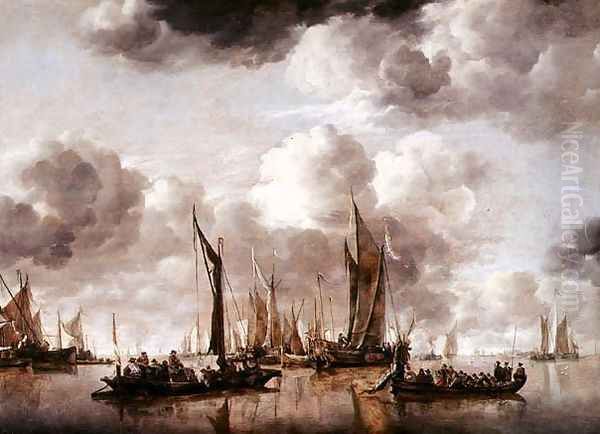
The Van de Veldes, Willem the Elder and Willem the Younger, were the leading Dutch marine painters in the latter half of the 17th century. While Van de Cappelle's style was generally calmer and more atmospheric than the often more dramatic or detailed documentary style of the Van de Veldes, they operated within the same artistic milieu. Willem van de Velde the Elder was known for his "pen paintings" (detailed ink drawings on prepared panels or canvases), and both father and son produced a vast number of works depicting naval battles and ship portraits. Van de Cappelle's focus remained on the poetic qualities of the sea.
Other marine painters active during or slightly before Van de Cappelle's time, whose work he might have known, include Hendrick Cornelisz Vroom, often considered the father of Dutch marine painting, and the aforementioned Jan Porcellis, who pioneered the "tonal" phase of seascape painting with its emphasis on atmospheric unity and monochrome palettes. Van de Cappelle built upon these foundations, infusing them with his unique sensitivity to light and tranquility.
His influence extended to later artists. The English Romantic painter J.M.W. Turner greatly admired Dutch Golden Age marine art, and Van de Cappelle's luminous, atmospheric qualities can be seen as a precursor to Turner's own explorations of light and atmosphere, albeit in a more dramatic and abstract vein.
The Collector's Eye: Cappelle's Own Trove
One of the most remarkable aspects of Jan van de Cappelle's life was his activity as an art collector. The inventory of his estate, compiled after his death in 1680, reveals one of the most extensive and high-quality private art collections of its time. This collection underscores his deep immersion in the art world and his discerning taste.
He owned approximately 200 paintings and over 7,000 drawings. The sheer volume of drawings is astonishing and included works by many of the most celebrated artists of the 16th and 17th centuries. The inventory lists nine paintings and over 1,300 drawings by Simon de Vlieger, further emphasizing his profound connection to this artist.
His collection of Rembrandt's works was particularly notable, featuring seven paintings and an astounding portfolio of around 500 of Rembrandt's drawings – virtually all the drawings by Rembrandt known at the time. This alone would make his collection legendary. He also owned paintings by Frans Hals, Hendrick Avercamp (renowned for his winter scenes), Adriaen Brouwer, Hercules Seghers (a highly original landscape painter and printmaker), Jan Lievens, and many others.
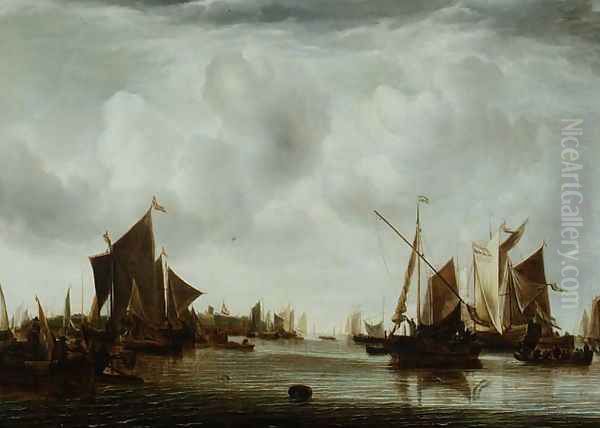
The breadth of his collection demonstrates a sophisticated understanding of art history and contemporary artistic production. It included Italian masters as well as Dutch and Flemish artists, spanning various genres from portraits and landscapes to marine scenes and genre paintings. This activity as a collector not only provided him with inspiration but also positioned him as a significant patron and connoisseur. His home must have been a veritable museum, a testament to his wealth and his passion for art. The dispersal of this collection after his death enriched many other collections across Europe.
Legacy and Market Presence: Enduring Appeal
Jan van de Cappelle's paintings have always been highly prized by collectors and connoisseurs. Their serene beauty, technical mastery, and relative rarity have ensured their desirability over the centuries. Today, his works are held in the collections of major museums around the world.
Prominent institutions housing his paintings include the National Gallery in London, the Rijksmuseum in Amsterdam, the Mauritshuis in The Hague, the Boijmans Van Beuningen Museum in Rotterdam, the Wallraf-Richartz Museum in Cologne, the National Gallery of Art in Washington D.C., and the Getty Museum in Los Angeles, among many others. The presence of his works in these prestigious collections attests to his enduring status as a master of Dutch marine painting.
On the art market, Van de Cappelle's paintings command high prices when they occasionally appear at auction. For instance, in 2019, his painting A Calm Sea sold at Sotheby's for £1.7 million. Another work, A Shipping Scene on a Calm Sea, achieved $4.8 million at auction, reflecting the strong demand for his top-quality pieces. These prices place him among the most valued Dutch Old Masters.
The portrait of his wife, Annetje Grotincx, attributed to him by some, or commissioned by him, is now in the Fondation Custodia in Paris, a center for the study of Old Master drawings. This further highlights the personal and artistic dimensions of his life.
Scholarly Perspectives: Evaluation and Debates
Art historians universally recognize Jan van de Cappelle as one of the preeminent marine painters of the Dutch Golden Age. His unique ability to capture tranquil moods and luminous atmospheric effects sets him apart. Scholars like Wilhelm von Bode, a pioneering German art historian, and later specialists in Dutch art such as Wolfgang Stechow and Seymour Slive, have lauded his contributions.
His development of the "parade" scene, often in conjunction with or following Simon de Vlieger, is seen as a significant contribution to the repertoire of Dutch marine art, reflecting the nation's pride in its maritime achievements during a period of relative peace and prosperity. His paintings are often interpreted as visual poems, celebrating the harmony between humanity and nature, and the quiet strength of the Dutch Republic.
Despite this general acclaim, some areas of scholarly discussion and debate persist. The exact nature of his artistic training remains somewhat elusive. While the influence of Simon de Vlieger is clear, the lack of guild records or documented apprenticeship leaves room for speculation about how he acquired his sophisticated technique. The prevailing view is that he was largely self-taught, learning through intense observation and practice, aided by his access to a vast collection of other artists' works.
Attribution can sometimes be a point of discussion, as is common with Old Masters. While his style is quite distinctive, the occasional work by a contemporary or follower might be debated. For example, some winter landscapes once attributed to him have been re-attributed by scholars to artists like Salomon Rombouts, who worked in a similar vein. However, the core body of his marine paintings is generally securely attributed.
Another point of interest for scholars is the trajectory of his artistic production. His most prolific period seems to have been in the 1650s. There is evidence that his output declined significantly after this decade, with very few, if any, dated works from the 1660s onwards. The reasons for this are not entirely clear but could be related to increased responsibilities in his business, changing personal circumstances, or simply a shifting of his passions.
His role as a collector is also a significant area of study, as it provides insights into his artistic tastes, his network, and the art market of the time. The sheer quality and quantity of works he owned, particularly the drawings by Rembrandt and De Vlieger, make his collection a subject of ongoing interest.
Conclusion: The Enduring Calm of Jan van de Cappelle
Jan van de Cappelle occupies a special place in the pantheon of Dutch Golden Age painters. As a wealthy industrialist who painted for pleasure, he brought a unique perspective and an unhurried dedication to his art. His serene seascapes and luminous winter scenes are celebrated for their exquisite rendering of light and atmosphere, their balanced compositions, and their profound sense of tranquility.
He masterfully captured the essence of the Dutch waters, not in moments of storm and drama, but in periods of calm reflection, mirroring the peace and prosperity that characterized much of the Golden Age. His influence, though perhaps not as wide-ranging as some of his contemporaries who ran large workshops, was nonetheless significant, particularly in his subtle and poetic approach to marine painting.
Through his surviving works, housed in museums and private collections worldwide, and through the legacy of his extraordinary art collection, Jan van de Cappelle continues to enchant viewers. He invites us to pause and contemplate the quiet beauty of a world where sky, water, and light merge in perfect harmony, a testament to his exceptional skill and his deep love for the maritime soul of the Netherlands. His paintings remain timeless windows onto a world of serene majesty.